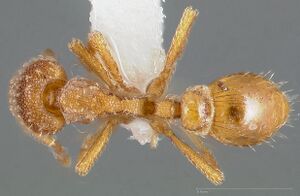Strumigenys ambatrix
| Strumigenys ambatrix | |
|---|---|

| |
| Scientific classification | |
| Kingdom: | Animalia |
| Phylum: | Arthropoda |
| Class: | Insecta |
| Order: | Hymenoptera |
| Family: | Formicidae |
| Subfamily: | Myrmicinae |
| Tribe: | Attini |
| Genus: | Strumigenys |
| Species: | S. ambatrix |
| Binomial name | |
| Strumigenys ambatrix (Bolton, 2000) | |
Occurs in a range of forest habitats and has been collected from numerous litter samples in eastern Madagascar.
Identification
Bolton (2000) - A member of the Strumigenys rostrata-group. Of the four species of this group found in Madagascar ambatrix is unique in possessing long flagellate hairs at the pronotal humeri. In the other three species the humeral hairs are simple and straight or only very shallowly curved .
Keys including this Species
Distribution
Latitudinal Distribution Pattern
Latitudinal Range: -15.66667° to -15.66667°.
| North Temperate |
North Subtropical |
Tropical | South Subtropical |
South Temperate |
- Source: AntMaps
Distribution based on Regional Taxon Lists
Malagasy Region: Madagascar (type locality).
Distribution based on AntMaps
Distribution based on AntWeb specimens
Check data from AntWeb
Countries Occupied
| Number of countries occupied by this species based on AntWiki Regional Taxon Lists. In general, fewer countries occupied indicates a narrower range, while more countries indicates a more widespread species. |

|
Estimated Abundance
| Relative abundance based on number of AntMaps records per species (this species within the purple bar). Fewer records (to the left) indicates a less abundant/encountered species while more records (to the right) indicates more abundant/encountered species. |

|
Biology
|
Castes
Worker
Images from AntWeb
   
| |
| Paratype of Strumigenys ambatrix. Worker. Specimen code casent0005446. Photographer April Nobile, uploaded by California Academy of Sciences. | Owned by CAS, San Francisco, CA, USA. |
   
| |
| Paratype of Strumigenys ambatrix. Worker. Specimen code casent0005447. Photographer April Nobile, uploaded by California Academy of Sciences. | Owned by CAS, San Francisco, CA, USA. |
   
| |
| Holotype of Pyramica ambatrix. Worker. Specimen code casent0005990. Photographer April Nobile, uploaded by California Academy of Sciences. | Owned by MCZ, Cambridge, MA, USA. |
Nomenclature
The following information is derived from Barry Bolton's Online Catalogue of the Ants of the World.
- ambatrix. Pyramica ambatrix Bolton, 2000: 255 (w.q.) MADAGASCAR. Combination in Strumigenys: Baroni Urbani & De Andrade, 2007: 115
Unless otherwise noted the text for the remainder of this section is reported from the publication that includes the original description.
Description
Worker
Holotype. TL 2.1, HL 0.56, HW 0.41, CI 73, ML 0.10, MI 18, SL 0.28, SI 68, PW 0.26, AL 0.60. Closely related to Strumigenys victrix and mostly matching the description given there, but differing as follows.
1 Pronotal humeral hair long and flagellate.
2 Mesonotum usually with 2 pairs of erect hairs.
3 Entire dorsal alitrunk, and propodeal declivity, densely sharply reticulate-punctate.
4 Ventral spongiform curtain of petiole extends the length of the segment, present beneath the peduncle but narrower there than beneath the node.
5 In dorsal view the postpetiole disc , from the posterolateral angles to the anterolateral angles, margined by spongiform tissue.
Paratypes. TL 2.0-2.1, HL 0.50-0.56, HW 0.40-0.42, CI 73-76, ML 0.09-0.11, MI 17-20, SL 0.26-0.28, SI 65-70, PW 0.24-0.28, AL 0.56-0.62 (10 measured). As holotype but number of mesonotal standing hairs apparently variable or affected by abrasion, with one or two pairs present.
Type Material
Holotype worker, Madagascar: 5.3 k m . SSE Ambanizana, Andranobe, 15°40'S, 49°58'E , 425 m., 21.xi.1993, sifted litter (leaf mold, rotten wood) rainforest, #926 (41)-1 (B.L. Fisher) (Museum of Comparative Zoology).
Paratypes. 1 worker and 1 queen (dealate) with same data as holotype; 20 workers and 4 queens (dealate) with same data but coded (2)-1 , (22)-2, (24)-1 , (25)-1 , (31)-1, (36)-1, (40)-1, (43)-1, (50)-1, (L.O.)-1 (University of California, Davis, The Natural History Museum).
References
- Baroni Urbani, C. & De Andrade, M.L. 2007. The ant tribe Dacetini: limits and constituent genera, with descriptions of new species. Annali del Museo Civico di Storia Naturale “G. Doria”. 99:1-191.
- Bolton, B. 2000. The ant tribe Dacetini. Memoirs of the American Entomological Institute. 65:1-1028. (page 355, worker described)
- Tang, K. L., Guénard, B. 2023. Further additions to the knowledge of Strumigenys (Formicidae: Myrmicinae) within South East Asia, with the descriptions of 20 new species. European Journal of Taxonomy 907, 1–144 (doi:10.5852/ejt.2023.907.2327).
References based on Global Ant Biodiversity Informatics
- Bolton, B. 2000. The Ant Tribe Dacetini. Memoirs of the American Entomological Institute 65
- Fisher B. L. 2003. Formicidae, ants. Pp. 811-819 in: Goodman, S. M.; Benstead, J. P. (eds.) 2003. The natural history of Madagascar. Chicago: University of Chicago Press, xxi + 1709 pp.

